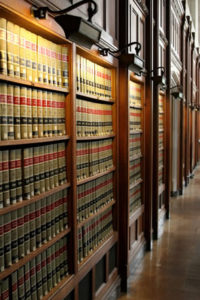Denver and Boulder Patent Searching
Patent Searching Services
The place to start with any type of patent application endeavor is with a patent search.
A patent search is important for at least three reasons:
- A patent search will determine whether or not you can patent your invention.
This is important because before you spend any money toward the application process, you should determine if protection is in fact available. If you idea is not patentable it is often useful to know if you can still produce the product, or whether someone else owns the patent rights to your invention. - A patent search is useful in drafting the patent.
A thorough patent search allows mer to gain the information required to draft the application in a manner that ensures the broadest possible protection for your invention. Plus, it cuts down on the time and money required to prosecute your application toward a patent. - A patent search gives you a stronger patent.
Knowing what the prior art is reduces the probability that the patent examiner misses a reference that could invalidate your patent should it issue.
Types of Patent Searching
Patentability Patent Searching
I conduct patentability searches (also called novelty searches) to determine if your invention meets the requirements of novelty, usefulness, and non-obviousness. The patent process usually begins with the patentability search, as such, patentability searches are the most common and essential type of patent search. The patentabillity search not only makes the application process easier but also helps to strengthen the invention against issues of invalidity in patent prosecution and infringement litigation.
Patentability / novelty searches are usually performed prior to the preparation of the patent application to determine if your intellectual property or invention is unique or novel enough to be patented. Each patentability search comes with a detailed description of the search conducted and a patentability opinion.
I provide Four basic types of Patentability Searches:
- USPTO Search (Limited Search)
USPTO patents and applications searched by keywords, image by image in subclasses, and using forward and backward citations. - USPTO and EPO Search
USPTO and EPO patents and applications (searching patents from over seventy countries) are searched by keywords, image by image in subclasses, and using forward and backward citations. - USPTO, EPO, and Commercial Databases Search
USPTO and EPO patents and applications (searching patents from over seventy countries) are searched by keywords, image by image in subclasses, and using forward and backward citations; as well as non-patent literature such as scientific journals and papers. - The Custom Patent Search
A custom patent search can be designed that searches non-patent literature in foreign languages that has not been translated into English and patent offices not covered by the EPO.
Software and Business Method Patent Searching
When the invention sought to be patented involves software, computer implemented methods, business methods, or internet related innovations patent searching can be more complicated. Most software and computer method inventions can be patented. The question is how many layers of specificity must be put into the scope of the claims in order to make the invention unique.
Unfortunatley, there is no cheap or easy way to search software or business methods; searching is more time intensive and thus costs more, an average software or business method patent might cost $2,200 to search.
The best method for seraching software and business method patents is to first find a few patents and patent applications that relate to the general purpose of the invention. Those references are sent to the inventor for for feedback regarding similarities and differences. This is usually quite useful, because once the inventor sees related patents a more complete description of the uniqueness of the invention can be discovered. I then go back and do a more specific, final, search. When the inventor receives the final search report, the inventor may be questioned about specific patents, and it may be necessary to do an additional quick search. When searching is finished a search report and patability opinion is issued. This iterative process takes more time, but it is the only reliable way to get a set of useful prior art references.
Chemical Patent Searching
Most chemicals have many different synonyms and possible name arrangements, making it virtually impossible to perform a successful search using a conventional keyword searches; thus, chemical patent searches require the use of databases that accept chemical formulas and structures as well as keyword and class searching. The software used to search chemical patents preprocess databases to recognize chemical units and convert them into standardized depictions for parsing.
With my background in molecular biology and chemistry I have no problem searching organic chemistry, Biotechnology, and genetics. Along with my personal expertise, I have access to chemical structure search databases through STN that include CAPLUS REGISTRY and MARPAT, as well as industry leading patent and prior art databases such as MicroPatent and Thomson Innovation.
Biological Patent Searching
Biological patent searching requires the use of amino acid or nucleotide sequences. Like chemical nomenclature, protien and genetic sequences don’t lend themselves to searches with the conventional databases.
When I search biological patents, I start by applying my expertise in biology to searching industry leading databases such as the CAS Registry, BIOSIS, CAPLUS, DGENE, PCTGEN, USGENE, and NCBI; my search report will include references to the availability of your sequence(s) as well as the sequence length, gene, organism, and patent family information related to the sequences in your references.
Freedom to Operate Patent Searching
A Freedom to Operate Search (FOS) includes a comprehensive search of unexpired US patents in order to determine if there is any danger that someone has a patent on your particular product or process. If relevant unexpired patents are found then this search will become an search to oppose or invalidate the patents of concern.
If you wish to commercialize a particular product or process in a country where there is a patent that claims what you want to use, sell, import, etc., then there are a number of questions about the patents of concern and what you can do to avoid them that a FOS search can answer for you:
- Design around
Knowing what patents and patent applications you need to design around is the first step toward designing around them. - Pending Applications
Pending applications turn into patents so they need to watched carefully; claims can be changed, and continuations in part can be filed. A close look at the application image file wrapper can tell where the patent application may be headed. - Terms of patents of concern
Issued patents remain active for 20 years from the date of filing plus any patent term extensions. Design patents stay live for 14 years from date of issue. - Maintenance fees
Issued patents may expire prior to the 20 year period (plus extensions) unless the maintenance fees are paid at 3.5years, 7.5 years, and 11.5 years from the date of the original patent grant (no maintenance fee is required for design patents). - Patent licensing
One easy way to avoid infringing a patent is simply to license it. - Cross-licensing
If a patent of concern partly cover your product or process, but other features are not covered you may want grant each other license to use each other’s patents.
State-of-the-Art Patent Searching
A State-of-the-Art (SOA) Patent Search gives you a broad perspective of an entire area of art and is primarily used to gather information about your competition and is often used as a sounding board for investors to gauge the potential of a start-up, but it is also used for general business planning, product programming, and a starting point for R&D efforts. Primarily patents and patent applications from the last 15-20 years are searched.
A state-of-the-art patent searching generally has the following features:
- A Patent Search
Depending on the class of invention an SOA search can produce anywhere from 20 to 300 patents; results can then be narrowed by year restrictions, inventors, assignees, or by other specified information about the invention. - Statistical Searching
Searches are performed using statistical indexes such as classification, file indexes or file-forming terms, keywords, applicants, and key dates. - Data Analysis
The search results can be analyzed to determine the inclination in a given field of invention to shift: from objects, materials, constructions, applications, applicants, inventors, period of pendancy before issue, etc. within the field of the invention.
Litigation and Infringement Patent Searching
A Litigation or Infringement Patent Search is primarily conducted for two reasons:
- To determine if a patent can be invalidated by undiscovered prior art.
- To determine if a patent application can be rejected by undiscovered prior art.
Essentially, this search is performed to invalidate a patent, as such it usually takes a standard search as a starting point and then searches far beyond a standard patentability search performed by the patent applicant or the patent examiner. The search may start with USPTO and EPO patents and applications but it really focuses on non-patent literature in English, but also in foreign languages, that would have been missed by prior searches.
Litigation and Infringement Patent Searches are charged hourly, with search coordination agreements charged at-cost. These searches can be quite expensive depending on how many languages are searched.
Excelerated Examination Patent Searching
On August 25, 2006, The United States Patent and Trademark Office (USPTO) launched a new Accelerated Examination Program with the aim to offer qualified applicants an opportunity to get an approved patent within 12 months of filing their application.
The Accelerated Examination Program requires an applicant to include a separate statement detailing the findings of a pre-examination search. This pre-examination search must include a comprehensive search of US patents, patent applications, foreign patents, and non-patent literature. The Accelerated Examination Support Document (AESD) requires the addition of an Information Disclosure Statement (IDS) quoting each portion of the reference wherein the examiner may locate each of the applicant’s claim limitations. The applicant must then provide a detailed description of how each claim in the application is patentable over the corresponding reference.
Accelerated Examination Searches are tailored specifically meet the requirement of filing an accelerated examination application by providing the standard patentability report as well as:
- Identifying where each claim limitation can be found in the prior art references.
- Explaining how each claim is patentable over the references.
- Providing support for each claim limitation.
- Identifying references that may be disqualified as prior art under 35 U.S.C. 103(c)
Essentially, the Excelerated Examination Patent Search is a full Patentability Search, and charged as such; with the addition of drafting the AESD and IDS – which are charged hourly.
Patent Lawyer Services
Patent law is primarily federal law, as such, the law firm of Hunziker Legal Services is happy to provide attorney services to those clients that come from around the world by phone, fax, letter, and email. If you live in any of the following areas you may also come to my Denver or Boulder, Colorado office to meet me in person, my patent law firm is located in Colorado close to: Denver, Boulder, Fort Collins, Loveland, Longmont, Broomfield, Westminister, Arvada, Northglenn, Thornton, Centennial, Lakewood, Brighton, Berkley, Aurora, Columbine, Commerce City, Englewood, Federal Heights, Golden, Greenwood Village, Highlands Ranch, Littleton, Parker, Sheryl Wood, Welby, and Wheat Ridge..
I offer the following services:
- Patent Searching
- Patent Drawings
- Provisional Patent Applications
- Utility Patents
- Software and Business Method Patent Applications
- Chemical and Biological Patent Applications
- Foriegn and PCT Patent Applications
- Design Patent Applications
- Plant Patent Applications
- Correction of Patents and Reissue Patent Applications
- Office Actions
- Interferences
- Appeals
- Patent Maintenance
- Patent Licensing and Assignments
- Patent Enforcement and Litigation
- Patent Opinions and Consultation
- Patent FAQ’s
- Patent Fees
Copyright claimed in formatting, modifications, and links exclusive of U. S. government Publication https://www.uspto.gov/web/offices/pac/doc/general/

About Will Hunziker
I am a patent and trademark attorney working in Boulder and Denver, Colorado where I provide cheap: patent, trademark, copyright, entertainment, corporate, business, and any other legal services you may require.
If you want a lawyer who answers your calls personally and charges a cheap rate, then you have found your man. I pride myself on the fact that each and every one of my clients gets the same zealous advocacy they can come to rely on again and again.

Hunziker Legal Services, PLLC.
A Professional Corporation
WillHunziker@gmail.com
Phone: (720) 310-0013
Fax: (720) 306-3017
Boulder Address:
1942 Broadway St. Suite 314
Boulder, CO 80302
Denver Address:

Geographic Regions of Practice:
Our lawyers and patent attorneys represent clients throughout Colorado; including residents of Boulder, Denver, Fort Collins, Loveland, Longmont, Broomfield, Westminister, Arvada, Northglenn, Thornton, Centennial, Lakewood, Brighton, Berkley, Aurora, Columbine, Commerce City, Englewood, Federal Heights, Golden, Greenwood Village, Highlands Ranch, Littleton, Parker, Sheryl Wood, Welby, and Wheat Ridge.






Use of HunzikerLegalServices.com the (‘Site’) is governed by the Site Usage Terms, use of the site constitutes acceptance of those Terms.
All rights reserved © 2007-18, Hunziker legal Services, PLLC
Site Usage Terms

